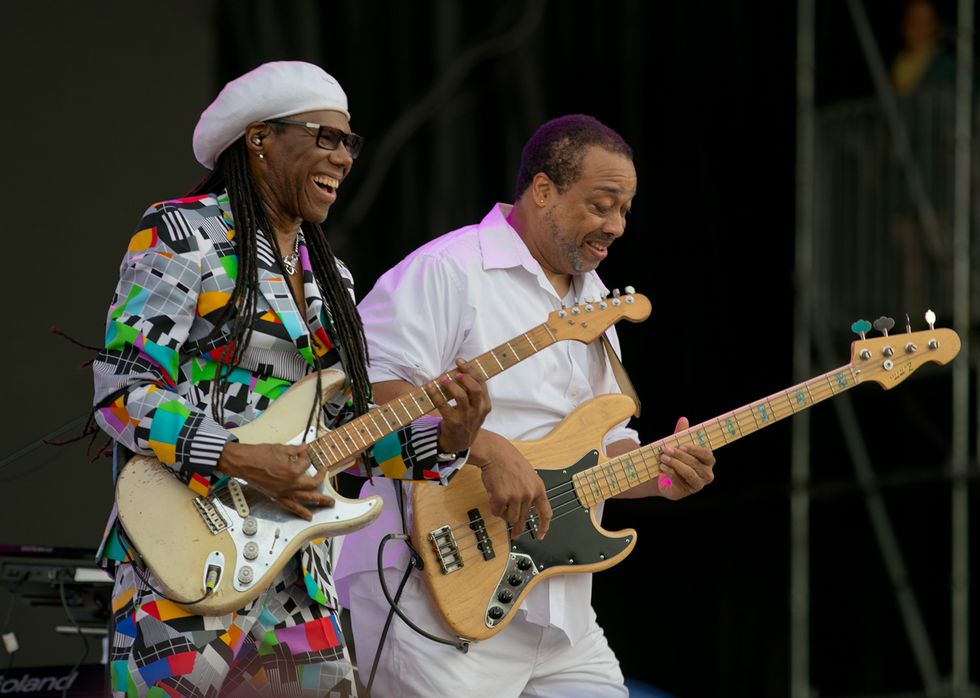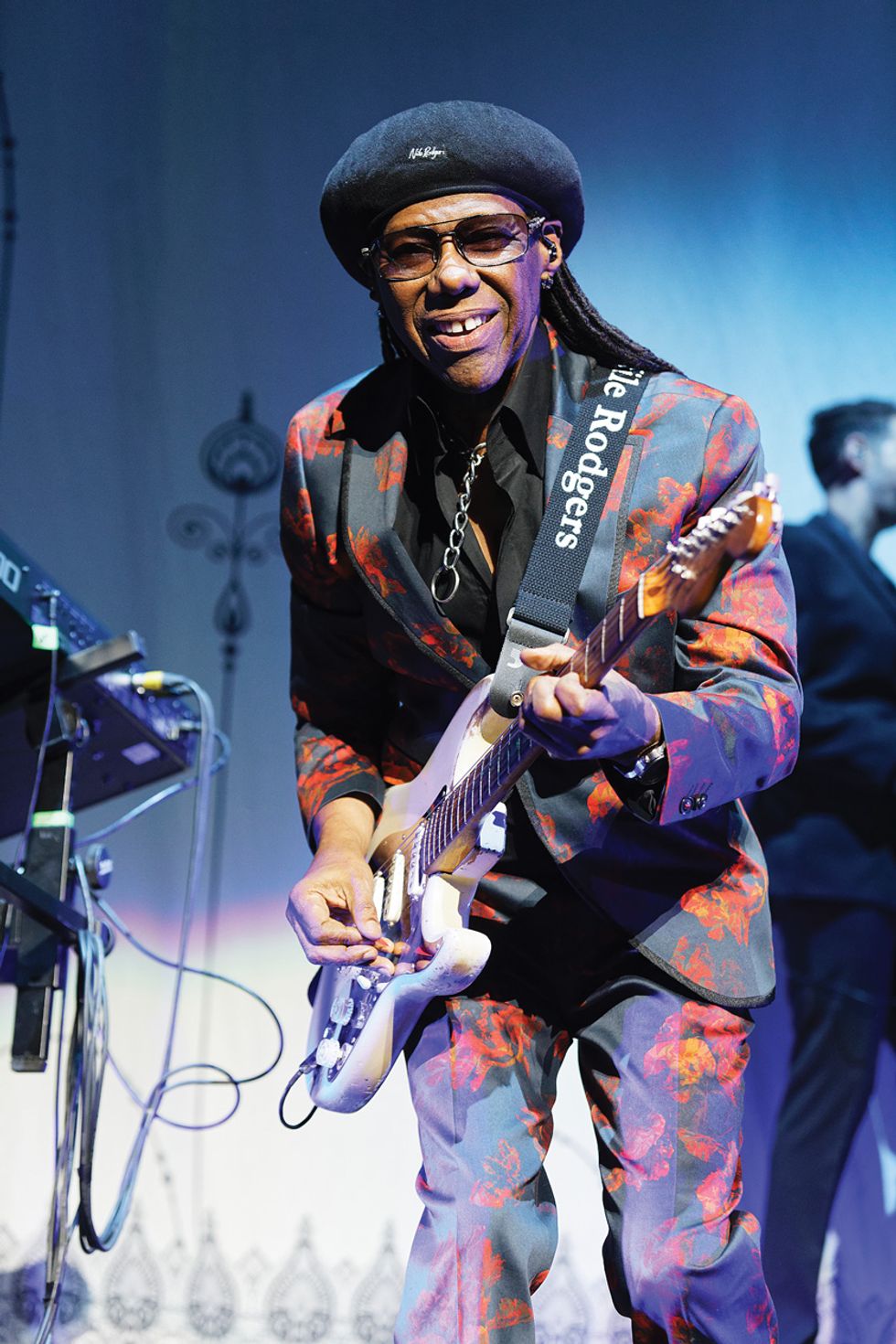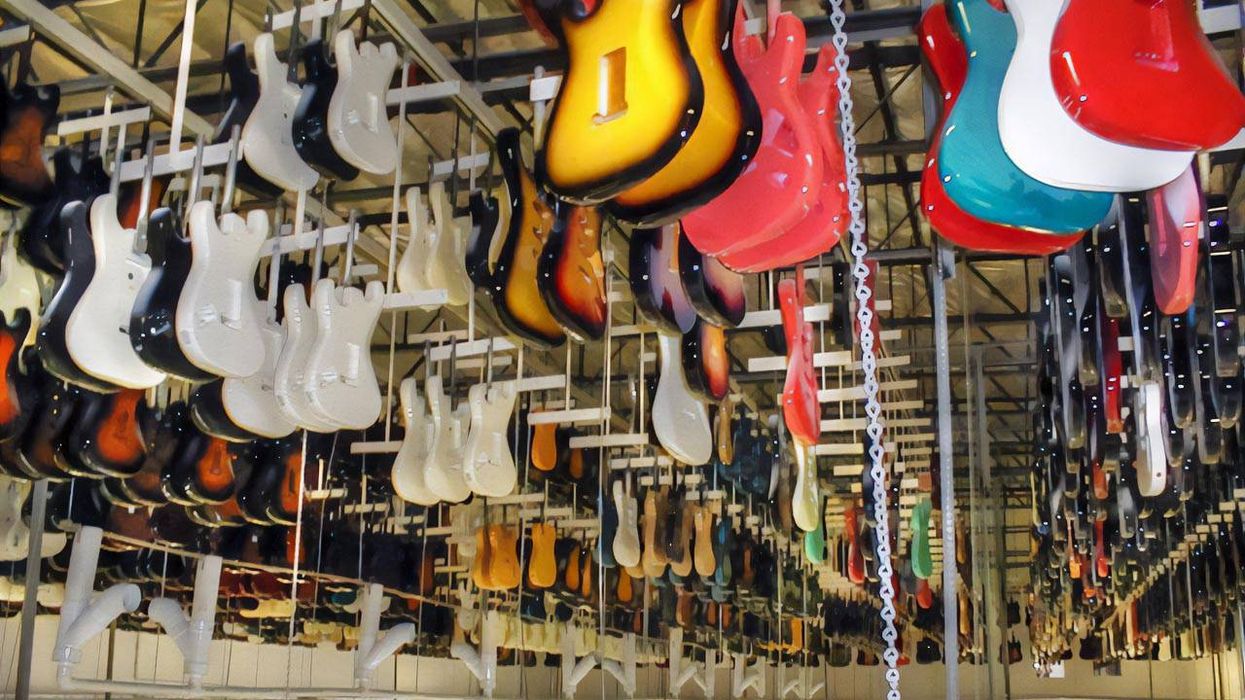Nile Rodgers’ playing is like an atom. Its nucleus is a blend of jazz and funk, essayed primarily via triads and a distinctive combination of string muting (left and right hand) and a fluid picking attack he calls his “chuck.” Then the electrons kick in—little harmonic and melodic colorations that orbit his core rhythm, all added with minimal movement and maximum focus. The net effect makes Rodgers a Stratocaster-strumming one-man band—or at least a complete rhythm section. Meanwhile, his conflagrant solos favor lightning chord changes or blues-howling single notes. And to describe his ringing, crystalline tones as “chic” is more than a bad pun.
But Rodgers isn’t just a colorfully attired hybrid of George Van Eps and Catfish Collins. His inquisitive nature and broad musical intelligence have made him a living legend of American music, with more hits than the Mafia. According to Billboard, Rodgers’ recordings with Chic, other projects of his own, and productions for the likes of Sister Sledge, David Bowie, Duran Duran, the B-52’s, Jeff Beck, Grace Jones, the Vaughan Brothers, Madonna, Adam Lambert, Laurie Anderson, and many others, total an astounding 500 million albums and 75 million singles sold.
Chic wasn’t just the band where he made his bones. The hits Rodgers cowrote with bassist and cofounder Bernard Edwards—including “Le Freak,” “Dance, Dance, Dance (Yowsah, Yowsah, Yowsah),” “I Want Your Love,” “Everybody Dance,” and “Good Times”—had a genius for capturing the zeitgeist of the late ’70s, a period when the struggles of the Civil Rights and Vietnam War eras gave way to the cultural free expression that was at the heart of disco and other blossoming subcultures.
That open-ended joie de vivre shifted when Reagan was elected, but this isn’t a story about the Gipper. It’s a conversation with a vibrant 68-year-old guitar hero who answered a recent Zoom call with a flurry of brilliantly choppy chords, á la Charlie Christian, on an unplugged Fender Acoustasonic Stratocaster. Said Acoustasonic has become a surprisingly large part of Rodgers’ musical life, especially considering his career largely unfolded on a single guitar—a 1960 Strat with a ’59 neck that he dubbed “the Hitmaker.” The new acoustic-electric hybrid first fell into Rodgers’ hands while he was conducting a songwriting workshop at Abbey Road Studios in London this past winter, and not long thereafter he volunteered to be a spokesman for it.
“It would never replace the Hitmaker,” he quickly points out. “I played the Hitmaker on all the songs with Chic, and when we play live it has to be that sound. But the Acoustasonic Stratocaster lets me live in this jazz world that I feel very safe and comfortable in. These days, with everything shut down, I’m loving that.”
The backdrop of our conversation was Rodgers’ office, which has enough platinum on its walls to buy a Maserati. But at the forefront was his history with the Hitmaker, his new romance with the Acoustasonic, early stage and studio experiences, his affection and commitment to the Fender Hot Rod Deville, and the cultural equity work of his 19-year-old We Are Family Foundation.
After 47 years playing the Hitmaker almost exclusively, why embrace the Acoustasonic Stratocaster?
I don’t know if Fender sent one to me to check out or whatever, but somehow an Acoustasonic was laying around at Abbey Road. When I picked it up, I started playing jazz chords and my amp setting was just perfect for that. So I started writing songs with the artists there, no matter the style of the song, using that guitar. It took me about three or four days to really get used to it.
What do you like about it?
It’s so light. I really like guitars that are easy to carry around. The Hitmaker is the lightest Strat I’ve ever held. Anyway, I was on tour with Cher when we went on lockdown, and my gear went into storage. The only guitars I brought home were the Hitmaker and the Acoustasonic, because they were so light and easy to fly with. The Acoustasonic ended up becoming one of the guitars in my bedroom. I wound up playing a lot of jazz on it. I don’t practice rock ’n’ roll. I don’t practice funk. But I practice jazz and classical. Mostly jazz. And it does the real thing for jazz … no amp or anything. Just unplugged. I love it!
I’ve seen posts [online] like, “What is Nile getting from Fender to plug this?” But they’ve got it backwards. I was on the phone to Fender and said, “I really like playing this!”
You’ve made a trippy video that demos parts of the Acoustasonic Stratocaster’s sonic range on a jazz instrumental called “Inside the Box.” It features a half-dozen Nile Rodgers, each one of you playing a different part and tone. How did that happen?
My friend [pianist] Philippe Saisse and I write a lot together, and we couldn’t see each other because we’re all inside a box—he’s quarantined in Los Angeles and I’m in Connecticut. So we composed this song, starting with a simple motif. [Sings the tune’s core riff.] When I was talking to Fender, I mentioned that maybe we could do something with it.
Here’s where it gets incredibly weird. I didn’t know how the guitar was supposed to function—with 20 acoustic and electric voices. I was mostly playing unplugged, and when I plugged in I had my amp set close to how I set it for the Hitmaker. So I’m getting ready to cut “Inside the Box” with my engineer, and he starts looking through the manual and telling me about what switch position does what. As we were recording, he was calling out different positions, like a coach calling out plays, for the different parts. Like, “I think this one’ll be more sympathetic to harmonics,” and “set it here and go down to the 5th fret, so you’re down an octave and it’ll really pop out.” It was really fun, and we got to see what the guitar could do in real time.
You mentioned you were already talking to Fender. What about?
I was talking to Fender almost every few days about a production model of the Hitmaker. [Fender’s Custom Shop made a limited edition in 2014.] But also, I heard they were going to discontinue the amp I use. And I was like, “Whoa, wait a minute! What am I gonna do when the gigs come back?”
A testament to the durability and genre-crossing appeal of Chic’s music was the band’s appearance at Bonnaroo in 2018. Of course, Rodgers brought the Hitmaker. Photo by Chris Kies
Which amp is that?
I use the Hot Rod Deville. It’s available to rent everywhere we go, and those amps are usually in good shape because the rock guys don’t typically rent them. I only carry my own gear here in America, so overseas it’s typically rented gear, and I like my sound with Chic to be consistent.
Your signature tone seems to be clean, bright, and articulate—with an accent on the highs and high mids?
You got it. When I switched to a Strat in 1973 to really get more inside of a funk and pop sound, I started to think about how to really project. Because of my jazz inclinations, I always keep my hand on the bridge, so it’s a muted sound. I noticed when I used 10" speakers they gave me better articulation than 12s. At that point, guitar players were even using 15" speakers, but that wasn’t where I was coming from. I was using a Vibrolux, and then I got a Sunn amp that had six 10s. If you look at the early Chic setup, you can see I had those on both sides of the stage. That was bright enough so I could always hear it, and I could feel comfortable. And when they came out with the 4x10 Deville, that really did it.
I’ve always been into new gear. From Chic’s very first gig, we were using wireless, so we’d start playing backstage with “Strike up the Band,” and we’d come out playing. We still play wireless. When I find something I like, I tend to stick with it. With the Deville, I was literally begging Fender to keep making it.
Typically, in the music business, relationships with corporations are somewhat adversarial. Like with my record label. I would see one of my records go to number one, but before it came out the label would tell me, “This is the worst piece of garbage I’ve ever heard.” So I would beg them to release it, and when it would go to number one, they’d say, “Oh, we always loved that song,” And I’d be like, What the…!”
So I’m accustomed to begging in this business, and I have no problem with that. When I found out Fender was going to stop making the Deville, I said, “Wait a minute! Let me beg! I’ll buy a bunch! Just make a bunch for me!” And out of that developed a relationship that’s really nice. I’m not used to having a corporation listen to me.
Rodgers performs with Chic vocalist Kimberly Davis at Detroit’s Little Caesars Arena in February 2019. The group, which today tours as Nile Rodgers & Chic, started in 1972 as the Big Apple Band. Photo by Ken Settle
You started on hollowbody jazz guitars, right?
Yes. I traded in a Barney Kessel and got $300 and a Strat for it. I got the runt of the litter—the cheapest guitar in the pawnshop. Switching over wasn’t a big deal. It wasn’t like playing a heavy Les Paul. The Hitmaker instantly felt comfortable. The thing I had to get used to was my hand not being further out from my body, because that’s how I learned to play.
Did you ever replace your Kessel? Those are pretty sweet guitars.
The thing is, as soon as I started making decent money, I went for guitars that were even more high-end. So my collection is really about the exceptional—1940s D’Angelicos and D’Acquistos, pre-War Martins. I wanted all of the important guitars. If Chuck Berry played it, I wanted it. If B.B. King played one, I wanted that, too. So I have a locker of maybe a couple hundred guitars, and they’re all awesome.
A lot of producers have a niche, but your production credits vary widely—from Duran Duran to Jeff Beck to Laurie Anderson. Did any of those projects come from out of the blue?
No. That doesn’t happen, because everything I do is based on some kind of personal relationship. That relationship can be only 10 minutes long—we meet, we talk, there’s a meeting of the minds, and we say, maybe one day let’s try something. For me, producing others is part of my wanting to get better and learn. I believe new artists, especially, have a lot to teach me. A lot of what I do comes from the world of analog. In the days of analog, we’d want to do something sonically tricky, and we didn’t have the technology for it, so we’d have to find a workaround. So my whole musical life revolves around the question “What if?” What if we tried this to make that sound? What if we approach this song differently to find a different meaning?
My credo is, for every record I do, I have only the artist’s best interests at heart. It’s not about me. I’ve done work 40, 20, 10, and even five years ago that I get paid for, so everything I do now is for fun and the love of music. It gives me uplift. I love to play and I want to get better.
What was it like playing with Stevie Ray and Jimmie live on the Vaughan Brothers’ Family Style?
The whole experience was enlightening. They wanted me to play because they loved my funk, my choppy style—which is the thing that Bernard Edwards taught me. Even if I’m playing jazz with a big band, I’m going to “chuck.” I play [the role of ] the ride cymbal like it gets played by a drummer. And even when I play blues, I’m playing like Freddie Green … chucking through it.
Stevie and David Bowie were the first people I met who talked about being sober. It was David first, in ’82, when we did Let’s Dance. At that point, Stevie wasn’t sober at all, but when he came in to do the Vaughan Brothers, he was. When I first met him, we fell in love with each other right away. But when this new Stevie who had reached a new place in his life through sobriety came back, it enlightened me—because I was also attempting to quit, but wasn’t successful then. Stevie had the kind of sobriety that I would go on to have. You’re not against other people drinking or getting high, but it’s just not for you anymore. I mean, getting high was some of the most fun times of my life, but it got to a point where it was taking away from my guitar playing. It made me complacent.

Guitars
“The Hitmaker” 1960 Fender Stratocaster with a 1959 neck
Fender American Professional Stratocaster
Fender Acoustasonic Stratocaster
Amps
Fender Hot Rod Deville 4x10
Effects
Boss DD-3 Digital Delay
Ibanez CS9 Chorus
Mad Professor Snow White Auto Wah
Ibanez TS808 40th Anniversary Tube Screamer
JAM Pedals Wahcko wah
Strings and Picks
D’Addario NYXL Super Light sets (.009–.042)
D’Addario Duralin Standard, Super Light Gauge picks (.50 mm)
Shure Axient wireless
Reference Laboratory RIC01/BK instrument cable
Korg Pitchblack tuner
Eventide PowerMax power supply
Radial SGI TX/RX Studio Guitar Interface
Pedaltrain Classic 2 Pedalboard
As fantastic as it was, it must have also been overwhelming to get caught up in the whirlwind success of Chic. Did that play some role in getting high as a lifestyle?
Our very first gig was in a nightclub in Atlantic City called Casanova’s, and the very next gig was playing in front of 70,000 people at the Oakland baseball stadium—the Kool Jazz Festival. I was terrified. I was so afraid that it was the beginning of my path to being a practicing alcoholic. I was backstage, literally shivering, and my guitar tech said, “Hey boss man, try one of these.” And he gave me a Heineken in a Styrofoam cup. I downed it real fast. I wasn’t even thinking. And that warm feeling came over me, and I hit the stage and I screamed out “Oakland!” And the crowd went “Chic,” and we were off and running. By the end of that tour, the drum riser would be covered with my white Styrofoam cups, because, you know, you get dehydrated. We were an opening act, so we were playing in the afternoon, and after every song I would have another cup of Heineken.
Typically when somebody gets sober, it takes a while to find new ground.
When I got sober, I was going to quit the music business, because the studio felt dangerous for me. The way I got back in it was Michael Jackson called me to play on his HIStory album. I told him I would do it if he would send a car for me so I could sit outside of the studio and then come in when he called me to play. He could give me a chart or teach me the tune, and I’d play my part, wait until he approved it, and then I’d leave.
I was eight months into sobriety, and with Michael, it just felt like home. I played my part in 10 minutes and we spent a long time talking. I realized my friends were all artists and these were the people I wanted to be around. I had to find the discipline to not do drugs or drink. And that was 26 years ago. If I’m around drugs or booze, it doesn’t really affect me. I enjoyed those days and hit it pretty hard, but the music is what I’m about and nothing gets in the way.
At 68 years old, I have more fun and more energy on a gig than when I was twentysomething, because at twentysomething I was afraid of the audience. Now, I bond with the audience. They’re my friends! Also, I’m a two-time cancer survivor, and there are people out there I have a relationship with because we all talk about fighting and surviving and trying to stay strong. So I feel like we share a spiritual connection. And I mean that in a metaphorical way, because I’m not in any way a religious dude.
When did you plant your studio roots?
Had it not been for Luther Vandross, I don’t know how long it would have taken me to break into the studio scene. Luther was making his second album, in 1976, and he told the arranger, Paul Riser, who was a genius, “I want you to hire my guitar player for the date.” Back then, we would use two or three guitar players on an R&B session, so I found myself sitting with Cornell Dupree and Jeff Mironov, and all these other guys whose names I knew from famous album credits, but had never met. I mean, sitting next to Cornell Dupree … awesome!
Since I have mostly a jazz and classical background, I’m an excellent music reader. Most guitar players I know … ummm. But I can read through notation, no problem. So we start the sessions and suddenly the conductor starts hearing things in the guitars that he didn’t write, so he stopped the session and said to me, “Hey youngblood, what is that bullshit you’re playing?” And I said—and I wasn’t trying to be a smart aleck, because I had respect for him—“I’m playing that bullshit you wrote right here.” I didn’t know what else to do, because I was on the spot. Luther, who knew I could read, said, “Why don’t you solo his track?” And it was right. From that moment, the session community embraced me. I started to get called for gigs, and I became friends with guys like Cornell and the Brecker Brothers, and they began to play on my records.
"At twentysomething I was afraid of the audience. Now, I bond with the audience. They’re my friends!" Photo by Jordi Vidal
How do you like to record guitars?
I go direct, and depending on the situation and the eventual outcome of the project or the guitar part I’m playing, I may decide to amp it. But in today’s world of so many options, there’s an unlimited palette of sounds I can use. Plus, my Hitmaker is so exceptional sounding by itself. Just last night I was remotely cutting parts for a tune, and just using the 5-position switch I was able to get a lot of variations for the different parts, including a pretty smoking solo—at least that’s what the artist wrote back to me. And beyond that, without getting too into the gearhead thing, I have a selection of high-end mics that’s really got everything covered.
You established the We Are Family Foundation 19 years ago to help empower young people who want to positively change their communities. And recently it established the Youth To the Front program to fight systemic racism and injustice by fueling the work of under-30 activists. What led you to establish the Foundation?
After the September 11 tragedies—and I had three people on the first plane who were part of my universe—people approached me about being part of the benefit concert for first responders at Madison Square Garden, and asked me to record and re-release the song “We Are Family” to jumpstart the process. Initially, I had reservations, because I had written that song [which reached No. 2 on Billboard’s Hot 100 in 1979] for Sister Sledge—about them being a family. But for other people, it had become something else—something larger—and people helped me determine that it could also be a healing song.
Because I was part of Live Aid, I understood that a charity really has to be more than a single event to have a long-term impact. So I wanted to do something that was sustaining. So I started the We Are Family Foundation in hopes that it would be as successful as the song. It’s really about trying to solve problems, through something as long-term as the new Youth To the Front program, or helping a teenager in a village on the other side of the world clean up the water his family keeps getting malaria from. It’s all important.
Nile Rodgers sits down in London’s Dean Street Studios to play unadorned guitar parts from some of Chic’s greatest hits, laying bare his uncanny blend of jazz-style changes and funk strumming in “Le Freak” and “Everybody Dance.”









![Rig Rundown: AFI [2025]](https://www.premierguitar.com/media-library/youtube.jpg?id=62064741&width=1245&height=700&quality=70&coordinates=0%2C0%2C0%2C0)












 Shop Scott's Rig
Shop Scott's Rig













 Zach loves his Sovtek Mig 60 head, which he plays through a cab he built himself at a pipe-organ shop in Denver. Every glue joint is lined with thin leather for maximum air tightness, and it’s stocked with Celestion G12M Greenback speakers.
Zach loves his Sovtek Mig 60 head, which he plays through a cab he built himself at a pipe-organ shop in Denver. Every glue joint is lined with thin leather for maximum air tightness, and it’s stocked with Celestion G12M Greenback speakers.












![Devon Eisenbarger [Katy Perry] Rig Rundown](https://www.premierguitar.com/media-library/youtube.jpg?id=61774583&width=1245&height=700&quality=70&coordinates=0%2C0%2C0%2C0)






